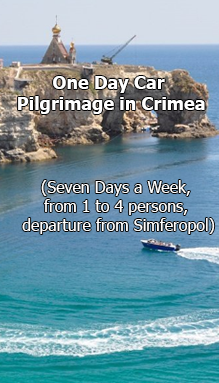St. Great Martyr George the Victorious Monastery near Cape Phiolent
| Status: | active monastery | |
| According to one of the legends it was founded in 891. Originally it belonged to the Constantinopolitan Patriarchate. The first record of the monastery dates back to 1578. From 1778 (the Christians’ outcome from Crimea) to 1794 the monastery does not function. From 1806 it becomes the base monastery for the Black Sea Fleet hieromonachs. New temples are built: 1816 — the Great Martyr George Temple, 1850 — the Exaltation of the Cross Temple, 1893 — the Cave Church of the Nativity of Christ. The monastery is closed in 1929. It was revived in 1994. In 2000 there started the building of the Great Martyr George Temple, ruined in 1927. | ||
| Location: | The City of Sevastopol, to the east from Cape Phiolent, on the rock coming abruptly to an end near the sea | |
The Monastery history
Not far from the City of Sevastopol near Cape Phiolent there is St. George the Victorious Monastery.
From the Sacred Legend it is known that in 891 the Greek seafarers were overtaken by the awful storm near Cape Phiolent. The sailors started to heartily pray St. George. The storm suddenly stopped and the Saint appeared before them on the rock. Having ascended the rock, they found there the icon with the image of George the Victorious. On returning to this place in a year, the saved founded a cave monastery here. To the end of XVIII c. the monastery was subordinate to the Constantinopolitan Patriarchate, and after the annexation of the Crimea to Russia was under the authority of the Sacred Governing Synod. The monastery was active till the Christians’ outcome to the Azov Region. In 1793 it was restored.
At the beginning of XIX c. the Chief Procurator of the Holy Synod A. N. Golitsin took a particular care of the St. George Monastery. According to his order the ancient church was dismounted and on its place new St. George Temple was built, where afterwards A. N. Golitsin was buried himself.
The ancient legend about Iphigenia is connected with this place. The earliest work with this plot which is known to us is the tragedy by Euripides «Iphigenia in Taurida» (V c. B.C.). The Temple of the Virgin was considered to be not far from St. George Monastery, but there is no reliable information about it. True, A.S.Pushkin, who visited St. George Monastery in 1820 with his friend Rayevskiy, wrote: “Here I saw the legendary ruins of the Temple of Diana”.
In 1825 St. George Monastery was visited by A. S. Griboedov. Having seen the Monastery sights, Alexander Sergeevich descended to the sea and bathed in the water which was as cold as ice. Having spoken to the father superior, the writer left for Sevastopol.
During the Crimean War of 1853–1856 English and French troops occupied the Monastery. For almost two years the monks were forbidden to leave the enclosure of the Monastery, in exchange they got from the enemy the provisions as well as wine, incense and candles, necessary for liturgy, and the services did not stop.
The Monastery was visited by A. K. Tolstoy, I. S. Aksakov, A. N. Ostrovskiy, I. A. Bunin, A. P. Chekhov. The Monastery views were depicted on the canvases by I. Aivazovskiy, V. Vereshchagin, M. Ivanov, V. Timm, K. Bossolli.
In 1891 for the celebration of the thousandth anniversary of the Monastery on the rock where St. George appeared there was erected the cross with the Saint’s image, and in 1893 the wooden temple above the Cave Church of the Nativity of Christ was replaced by the stone one.
In 1898 the Monastery was visited by the Emperor Nicholas Alexandrovich with the Empress. He took part in the laying of the cathedral temple in the name of the Ascension of Our Lord Jesus Christ in commemoration of delivering from the danger, he was exposed to during the visit to Japan in 1891.
Year 1929 turned out to be a weird one for St. George Monastery: the Monastery was liquidated, the premises were given to the health resort trust. The articles of worship and church vessels were ransacked, St. George Monastery Temple was ruined and dumped by the bulldozer off the rock, and on its place а dancing area was made. In the building of the Church of the Exaltation of the Holy Cross one set up the library of the military unit, on the place of the alter a furnace was built, the Monastery territory was furnished with sewers, which soon outwore and clogged St. George spring. The Second World War did not spare the Monastery either. The hotel, brethren’s building, refectory, monastic cells turned into ruins.
On the 6th of May 1993 in the Monastery His Eminence Lazarus celebrated the first after the war Divine Liturgy. At the ceremonial service the Commander-in-Chief of the Black Sea Fleet E. Baltin was present. A year later a part of the former Monastery territory was returned to the diocese. Regular services in the Monastery began on the 7th of April 1996 on the holiday of the Annunciation of the Mother of God.












